Sphingidae: Philampelini: Eumorpha of Peru, not updated fo rArgentina yet
Eumorpha phorbas, Shima, Junin, Peru,
June 12, 2010, courtesy of Peter Bruce-Jones.
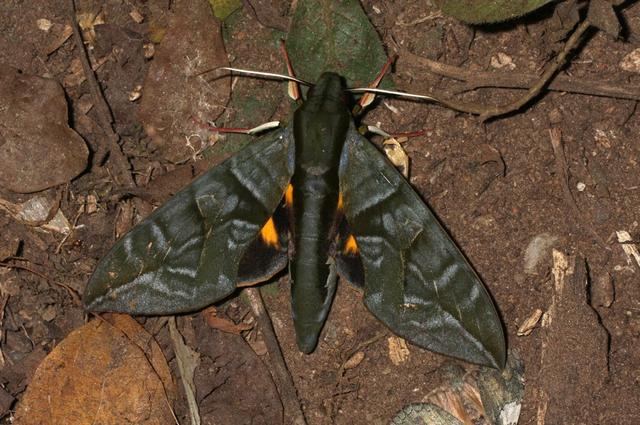
Eumorpha phorbas, Shima, Junin, Peru,
June 12, 2010, courtesy of Peter Bruce-Jones.
This is a very tentative checklist based
primarily on a checklist I had compiled for Ecuador so I fully expect
there are omissions and some erroneous inclusions. If you have
corrections to offer, please contact
This page is inspired by Peter Bruce-Jones who has sent me many images and much data for Sphingidae found in Peru.
Bill Oehlke at
oehlkew@islandtelecom.com.
 |
Eumorpha fasciatus, the Banded Sphinx |
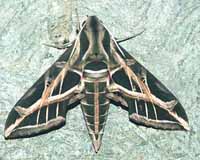 | Eumorpha vitis the Vine Sphinx: Forewing is generally quite similar to fasciatus, but note much longer internal extension of the lowest thin beige post median line into the median area. In fasciatus, this lower thin line in the median area is only a very short dash before meeting the broad transverse lines. Vitis lacks the broad pink band, found in fasciatus, along the hindwing outer margin. |
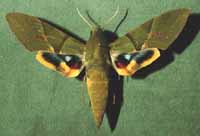 | Eumorpha labruscae the Gaudy Sphinx: Fw ground colour bright green to grey-green with a darker triangular median area, delineated by very dark am line and dark median line. There is a brownish blotch near midpoint of outer line of darker triangular area, followed by a beige blotch along the inner margin. |
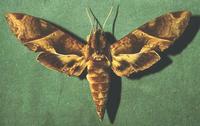 | Eumorpha anchemolus: Fw o. m. slightly crenulated. Similar to Eumorpha triangulum, but fw upperside pattern less contrasting and variegated. Dark subapical costal patch truncated on Rs4. White fringe along i. m. from body to slightly beyond median rhombiform patch very conspicuous. |
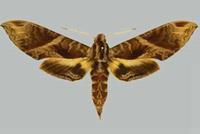 | Eumorpha cissi: Similar to anchemolus, but ground colour: dark greenish-grey; anchemolus: brown. Cissi has more falcate apex. Cissi lacks strongly contrasting white fringe extending (in anchemolus) from body to slightly past dark rhombiform region. Two well defined zigzag lines in pale area along i. m. between dark rhombiform region and anal angle. ? eastesn Colombia |
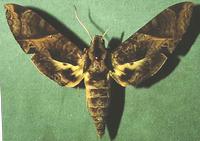 | Eumorpha triangulum: Note the dark trapezoidal patch emanating from the costa just prior to the apex. In E. triangulum this patch continues into the next intraneural segment, giving triangular appearance, while in the very similar E. anchemolus same area remains a trapezoid without "tailed" extension into the next section. Rain forest/cloud forest species unlikely at lower elevations. |
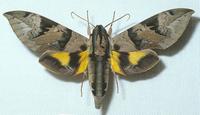 | Eumorpha capronnieri Fw ground colour grey to brown with distinct pattern of mottled green and darker brown areas. Forewing apex is slightly more produced and pointed in capronnieri, compared to phorbas. Note the outward extensions of dark green-brown stripes on abdominal tergites 5 and 6. |
Go to Indices of Nations
Use your browser "Back" button to return to the previous page.
This page is brought to you by Bill Oehlke and the WLSS. Pages are on space rented from Bizland. If you would like to become a "Patron of the Sphingidae Site", contact Bill.
Please send sightings/images to Bill. I will do my best to respond to requests for identification help.
Visit Argentina Thumbnail Checklists:
Sphingini: Manduca
Sphingini: Agrius, Amphimoea, Cocytius, Euryglottis, Lintneria, Sphinx
Smerinthini: Adhemarius, Orecta and Protambulyx
Dilophonotini: Aleuron, Enyo, Pachygonidia and Unzela
Dilophonotini: Aellopos, Eupyrrhoglossum, Nyceryx and Perigonia
Dilophonotini: Callionima, Erinnyis, Hemeroplanes, Isognathus, Madoryx, Oryba, Pachylia, Pachylioides, Phryxus
and Pseudosphinx
Philampelini: Eumorpha
Macroglossini: Hyles and Xylophanes
 Show appreciation for this site by clicking on flashing butterfly to the left. The link will take you to a page with links to many insect sites. |